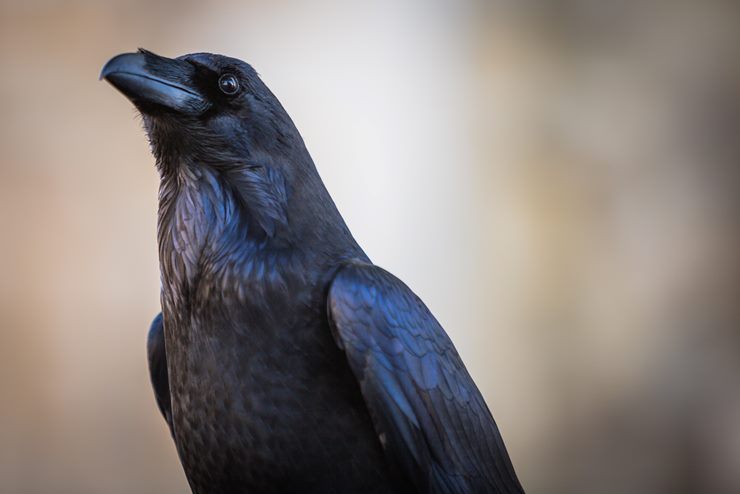Ravens are large, black birds in the genus Corvus. They are related to crows, and the two are often mistaken for one another. Species of ravens generally tend to be larger than those of crows.
Table of Contents
Common Ravens are distributed throughout the Northern Hemisphere in almost every habitat, including forests, plains, tundra, and desert. They even live successfully around humans in rural areas and towns.
When ravens form groups, their bright eyes surrounded by the unrelenting black of their glossy feathers can appear creepy to people who feel their unblinking stares. This abnormal staring behavior led people to call a group of ravens an Unkindness.
Other common collective nouns include:
- Flock
- Treachery
- Conspiracy
- Rave

Ravens are intelligent birds. They cache their food to protect it from their competitors and only hide it when they believe other ravens are not watching. If another raven finds a hidden cache of food, they will steal the food from their competitor’s hiding place and put it into their own.
Like crows, ravens can identify individual humans. This ability allows them to remember dangerous humans for years after an encounter. In addition, ravens can communicate their knowledge about dangerous humans to other ravens.
Food caching and communication within the flock are not the only intelligent things ravens can do. Ravens can also mimic the sound of human voices. However, this mimic skill is only in ravens that live with humans.
What is a Group of Baby Ravens Called?
A group of baby ravens does not have a specific name. Female ravens lay between three and seven eggs in their nest. The female incubates the eggs for around 20 to 25 days before hatching. While the female incubates the eggs, the male hunts food for both of them.
When the eggs hatch, the male and female take turns to tend the hatchlings. The baby ravens fledge and leave the nest around four to seven weeks after hatching. Even though the juveniles can fend for themselves, they often stay with their parents for up to six months after fledging.
Juvenile ravens are playful, curious animals. They interact with and investigate every object they encounter, discovering the world around them. Their capacity to learn is remarkable and has helped this species persist despite persecution from superstitious humans.
Ravens in the wild can live for an average of 15 years. The oldest recorded wild bird was over 22 years old. Captive birds, on the other hand, can live for 50 years.
What is a Pair of Ravens Called?
Ravens only pair up during the breeding season. These breeding pairs of ravens do not have a specific name. Their courtship display consists of acrobatic moves while flying and demonstrations of intelligence.
Male and female ravens work together to build the nest, but females do most of the work. They build nests on top of tall man-made structures, in large trees, and on the sides of cliffs. The nests contain sticks, mud, and an inner lining of fur tufts. The ravens aggressively defend their territory from other ravens.
Ravens are often monogamous and return to their nesting site area each year. These monogamous pairs usually stay together for years. When one dies, the other chooses a new partner. Both ravens alternate hunting for food and guarding the nest while raising their young.
Most potential predators avoid preying on ravens because male and female ravens are skilled defenders. They drop rocks on aerial predators and aggressively defend their young, food sources, and territory.
Do Ravens Flock Together in Groups?
Ravens spend much of their time during the day alone; however, they occasionally flock together in groups. The carcass of a freshly-dead animal will usually cause local ravens to gather in a group together to feed. Some ravens will call out and alert others to a dead animal.
Ravens are opportunistic, omnivorous birds that will eat anything they can find. Sources of food that ravens use include carrion, rodents, lizards, frogs, insects, eggs, small birds, and garbage. Sometimes ravens share their food source with others, while other times, they hide it away.
Ravens roost together in groups at the end of the day. Some scientists believe that ravens roosting together use that time to share information. These birds gather in a similar location each evening, forming loose flocks for protection.
Do Ravens Migrate?
Ravens do not migrate like other large birds. Even in the extreme northern parts of their range in Canada and Northern Europe, they do not fly far from their summer residence. During the harsh, northern winters, ravens will forage on carrion and hunt small animals.
Some scientists believe that as the climate continues to change and the southern ranges of ravens are lost, their territories will expand farther north. Their conservation status is of Least Concern, even with the predicted changes due to climate.
